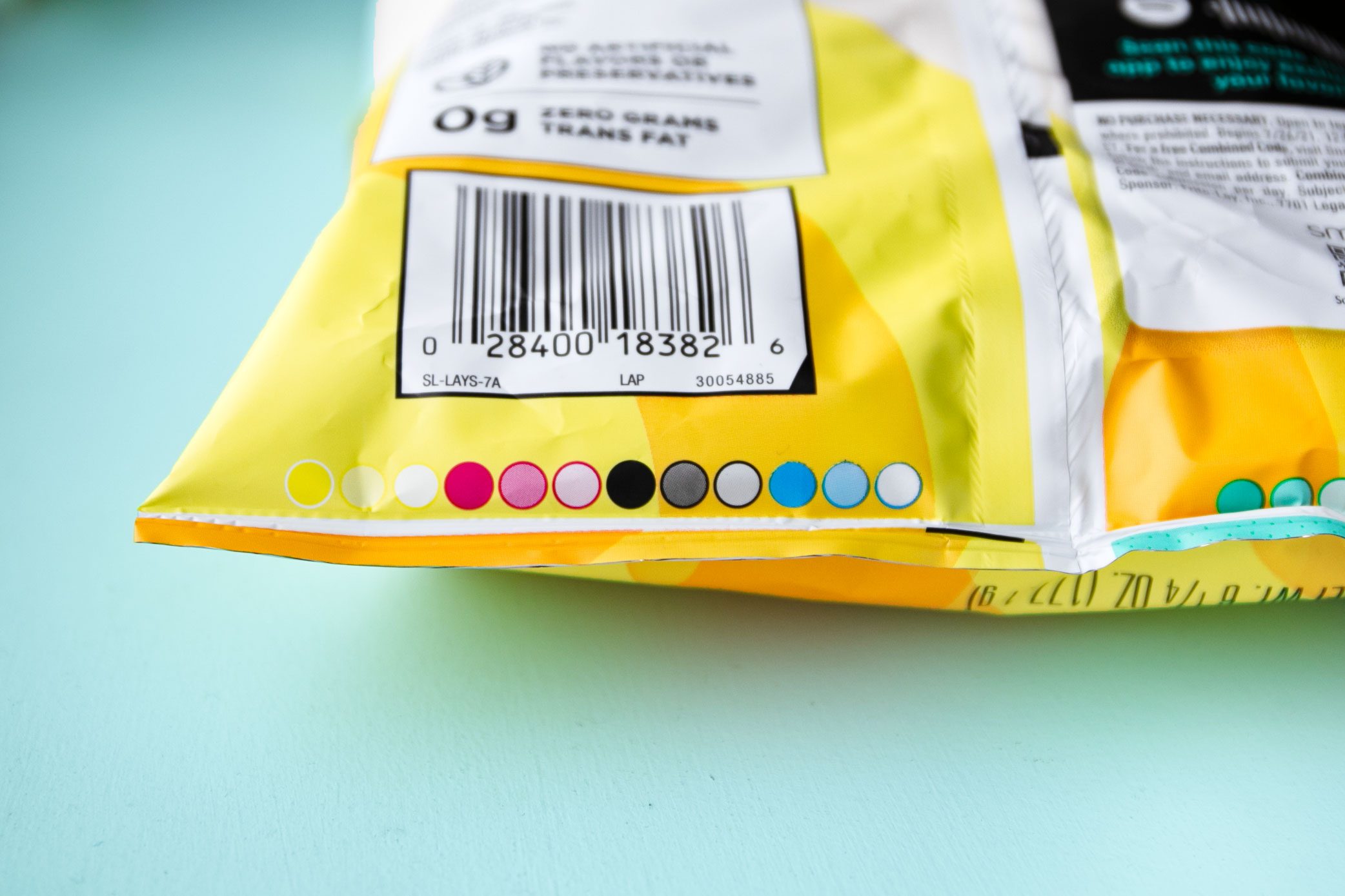Wondering what those colored circles on food packaging really mean? The answer is more technical than you might think.

Here’s What Those Colored Dots on Food Packaging Really Mean

If you’ve ever gone into a semi-fugue state while devouring a bag of chips (just us?), you may have missed some key details about the package. No matter your chip flavor of choice, there are bound to be seemingly random colored dots on the packaging. Turns out, they’re not a secret snack code—or a sign the chips are about to expire.
“There’s a mysterious book that guides every tiny detail of the packaged foods and products you buy at the grocery store,” says Dave Schaff, vice president of marketing for a major food label and a 20-year expert in consumer packaged goods. “It is built on scientific and psychological principles and has the power to convince people to buy almost anything—yet most consumers don’t even know this book exists.”
It’s called a brand book, and every major brand has one. These books are massive—hundreds of pages dictating everything from logo design to display shelf height to the exact materials used for packaging. And yes, nearly every brand book includes those little rainbow-colored dots you see on food packaging.
But what are the colored circles on chip bags and other packaged goods, exactly? To find out, we asked Schaff and registered dietitian nutritionist Umo Callins, to explain that and other details you should pay attention to on your food packages.
Get Reader’s Digest’s Read Up newsletter for more food insights, humor, travel, tech and fun facts all week long.
What kinds of foods tend to have these colored dots on their packaging?
You’ll find those dots on pretty much all commercial packaged goods, including food and nonfood items, Schaff says. Some of the most common items include:
- Candy wrappers
- Cereal boxes
- Chip bags
- Frozen food bags
- Juice and soda bottles
- Pasta boxes
- Snack bars
OK, so you know where to find them. The big question: What are the colored dots on chip bags and the like? Let’s investigate.
What do the colored circles on food packaging mean?
The colored dots, called color control patches, are a type of registration mark—little symbols that help the manufacturer ensure that packaging is printed correctly and aligns with the brand book. (Other registration marks you might see on food packaging include targets, crosshairs and color bars.) The dots serve as a way for printers to color-match, ensuring that, for instance, each bag of Lay’s Classic Potato Chips is the same exact shade of sunny yellow.
“Food packaging is a science, especially when it comes to how we use color, so it’s extremely important that we have consistency between manufacturers,” Schaff says. “Because we have manufacturers all over the world, all working with different types of equipment, we include the color control patches in the brand book to ensure they’re printed correctly.”
Are the colored dots on packaging really that big of a deal?

Yes, he says, especially when it comes to food brands. In helping printers match a package’s colors to the brand book, the colored circles ensure the packaged food looks just as the company intended. And companies are intentional about how items appear on shelves. “There’s a lot of psychology behind color choices. We use very specific colors to make a brand recognizable and to communicate taste and flavor,” he says.
One popular example: The specific shade of blue used on Cool Ranch Doritos is so iconic that people simply call them “the blue Doritos” and may not even know the flavor name. Similarly, when you go to buy a Gatorade, do you look for the Glacier Freeze flavor, or do you grab the light-blue Gatorade? The brand knows its customers shop by color and has leaned in to this by naming its most popular flavor Cool Blue.
“In this case, the color is more important to identifying the product to the customer than the name. Color is the consumer identifier,” he adds. “So if the printer gets it wrong, you can lose a lot of sales.”
It would be better if customers didn’t fall for flashy colors and instead looked at the nutrition label, ingredients list and serving sizes, Callins says. “These are often overlooked, but they are the most important things to pay attention to when deciding whether or not to buy a product,” she says. Alas, companies spend boatloads of money to develop snazzy packaging because it sells.
Do the colors have specific meanings?
Not really! The colored circles aren’t tied to things like ingredients or nutritional information. Instead, they represent the different ink colors used in printing. Most packages use cyan, magenta, yellow and black ink (known as CMYK), but other colors may appear, depending on the brand’s design.
Do these colored dots have anything to do with the item’s expiration dates?
Nope! If you’re looking for expiration or best-by dates, check these spots instead:
- The back or bottom of the package
- The seal of a chip bag
- The side panel of a cereal box
- Near the barcode or nutrition label
What does it mean if food packaging doesn’t have these colored dots?
If a package lacks these dots, it doesn’t mean anything is wrong with it. Some printing methods don’t require them, and some quality-control processes happen digitally. The colored dots on food packaging aren’t legally mandated, but the brand may require them.
What other symbols should you pay attention to on food packaging?
Food packages are designed to immediately draw your eye to the things the manufacturer wants you to notice, and they will “hide” things the manufacturer doesn’t want you to pay attention to, Schaff says. “There is a hierarchy of information on food packages. Usually, the brand name will be the biggest and most attention-catching detail,” he says. “I would pay more attention to the small or hidden symbols—the stuff they don’t want you to see.”
Callins says the most important aspects of a food package are the nutrition label and the ingredients list. “Ingredients are listed in descending order by weight, so the first few items you see will be present in the most amounts of the product,” she says.
While colored dots on food packaging don’t indicate anything important for shoppers, these symbols and phrases do:
-
Expiration and best-by dates: These tell you how long the product is at peak quality.
-
Lot codes and batch numbers: These are used for quality control and tracking recalls.
-
Recycling symbols: These indicate whether the packaging is recyclable and what type of plastic it is.
-
USDA Organic seal: This label is regulated and ensures the product meets organic standards.
-
Fair-trade and non-GMO labels: These signal ethical or non-genetically modified ingredients.
-
Allergen warnings: These highlight the presence of allergens like nuts, dairy or soy.
-
Storage instructions: These tell you if the product needs refrigeration after opening or must be stored at a certain temperature or away from light.
Schaff adds that there is one symbol found on food packaging he personally hates: the “all-natural” label. It is usually something healthy looking, like a green leaf, a tree, a sprouting plant or just the words in a fancy font. But regardless of how it looks, it’s meaningless. “All natural doesn’t have any regulated meaning, so manufacturers can make it mean anything they want,” he explains. “This can give really unhealthy products a ‘health halo,’ tricking consumers into buying them, thinking they are a health food.”
Callins agrees. “The claims you see on the front of the package are geared to catch your attention,” she says. “However, not all of them are backed by strict regulations. Terms like immune boosting or gut healthy can be misleading since there isn’t a clear definition. Verify claims by checking the nutrition facts label and ingredients list.”
About the experts
|
Why trust us
At Reader’s Digest, we’re committed to producing high-quality content by writers with expertise and experience in their field in consultation with relevant, qualified experts. We rely on reputable primary sources, including government and professional organizations and academic institutions as well as our writers’ personal experiences where appropriate. We verify all facts and data, back them with credible sourcing and revisit them over time to ensure they remain accurate and up to date. Read more about our team, our contributors and our editorial policies.
Sources:
- Dave Schaff, vice president of marketing for a major food label and expert in consumer packaged goods; phone interview, Feb. 15, 2025
- Umo Callins, RDN, CSSD, founder and owner of Well Rooted Health and Nutrition; email interview, Feb. 15, 2025























